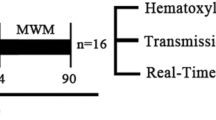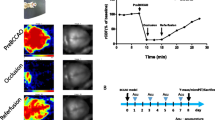Abstract
Vascular dementia (VaD) is caused by the reduction of blood supply by vessel occlusion and is characterized by progressive cognitive decline. VaD incidence has been growing due to the aging population, placing greater strain on social and economic resources. However, the pathological mechanisms underlying VaD remain unclear. Many studies have used the bilateral common carotid artery occlusion (BCCAO) animal model to investigate potential therapeutics for VaD. In this study, we investigated whether bee venom (BV) improves cognitive function and reduces neuroinflammation in the hippocampus of BCCAO animals. Animals were randomly divided into three groups: a sham group (n = 15), BCCAO control group (n = 15), and BV-treated BCCAO group (n = 15). BCCAO animals were treated with 0.1 μg/g BV at ST36 (“Joksamli” acupoint) four times every other day. In order to investigate the effect of BV treatment on cognitive function, we performed a Y-maze test. In order to uncover any potential relationship between these results and neuroinflammation, we also performed Western blotting in the BCCAO group. Animals that had been treated with BV showed an improved cognitive function and a reduced expression of neuroinflammatory proteins in the hippocampus, including Iba-1, TLR4, CD14, and TNF-α. Furthermore, we demonstrated that BV treatment increased pERK and BDNF in the hippocampus. The present study thus underlines the neuroprotective effect of BV treatment against BCCAO-induced cognitive impairment and neuroinflammation. Our findings suggest that BV may be an effective complementary treatment for VaD, as it may improve cognitive function and attenuate neuroinflammation associated with dementia.




Similar content being viewed by others
References
Versijpt J (2014) Effectiveness and cost-effectiveness of the pharmacological treatment of Alzheimer’s disease and vascular dementia. J Alzheimers Dis 42(Suppl 3):S19–S25. doi:10.3233/JAD-132639
Dubois MF, Hebert R (2001) The incidence of vascular dementia in Canada: a comparison with Europe and East Asia. Neuroepidemiology 20(3):179–187
Kammoun S, Gold G, Bouras C, Giannakopoulos P, McGee W, Herrmann F, Michel JP (2000) Immediate causes of death of demented and non-demented elderly. Acta Neurol Scand Suppl 176:96–99
Yang EJ, Cai M, Lee JH (2015) Neuroprotective effects of electroacupuncture on an animal model of bilateral common carotid artery occlusion. Mol Neurobiol. doi:10.1007/s12035-015-9610-7
Nayak D, Roth TL, McGavern DB (2014) Microglia development and function. Annu Rev Immunol 32:367–402. doi:10.1146/annurev-immunol-032713-120240
Lopez-Valdes HE, Martinez-Coria H (2016) The role of neuroinflammation in age-related dementias. Rev Investig Clin 68(1):40–48
Deng X, Li M, Ai W, He L, Lu D, Patrylo PR, Cai H, Luo X et al (2014) Lipolysaccharide-induced neuroinflammation is associated with Alzheimer-like amyloidogenic axonal pathology and dendritic degeneration in rats. Adv Alzheimer Dis 3(2):78–93. doi:10.4236/aad.2014.32009
Lee YJ, Choi DY, Yun YP, Han SB, KW O, Hong JT (2013) Epigallocatechin-3-gallate prevents systemic inflammation-induced memory deficiency and amyloidogenesis via its anti-neuroinflammatory properties. J Nutr Biochem 24(1):298–310. doi:10.1016/j.jnutbio.2012.06.011
Suh SJ, Kim KS, Kim MJ, Chang YC, Lee SD, Kim MS, Kwon DY, Kim CH (2006) Effects of bee venom on protease activities and free radical damages in synovial fluid from type II collagen-induced rheumatoid arthritis rats. Toxicol in Vitro 20(8):1465–1471. doi:10.1016/j.tiv.2006.06.016
Son DJ, Lee JW, Lee YH, Song HS, Lee CK, Hong JT (2007) Therapeutic application of anti-arthritis, pain-releasing, and anti-cancer effects of bee venom and its constituent compounds. Pharmacol Ther 115(2):246–270. doi:10.1016/j.pharmthera.2007.04.004
Chung ES, Kim H, Lee G, Park S, Kim H, Bae H (2012) Neuro-protective effects of bee venom by suppression of neuroinflammatory responses in a mouse model of Parkinson’s disease: role of regulatory T cells. Brain Behav Immun 26(8):1322–1330. doi:10.1016/j.bbi.2012.08.013
Yang EJ, Jiang JH, Lee SM, Yang SC, Hwang HS, Lee MS, Choi SM (2010) Bee venom attenuates neuroinflammatory events and extends survival in amyotrophic lateral sclerosis models. J Neuroinflammation 7. doi:10.1186/1742-2094-7-69
Seo SW, Jung WS, Lee SE, Choi CM, Shin BC, Kim EK, Kwon KB, Hong SH et al (2008) Effects of bee venom on cholecystokinin octapeptide-induced acute pancreatitis in rats. Pancreas 36(2):e22–e29. doi:10.1097/MPA.0b013e31815a396b
Gu SM, Park MH, Hwang CJ, Song HS, Lee US, Han SB, Oh KW, Ham YW et al (2015) Bee venom ameliorates lipopolysaccharide-induced memory loss by preventing NF-kappaB pathway. J Neuroinflammation 12. doi:10.1186/s12974-015-0344-2
Ye M, Chung HS, Lee C, Yoon MS, Yu AR, Kim JS, Hwang DS, Shim I et al (2016) Neuroprotective effects of bee venom phospholipase A2 in the 3xTg AD mouse model of Alzheimer’s disease. J Neuroinflammation 13(10). doi:10.1186/s12974-016-0476-z
Cho KO, Kim SK, Cho YJ, Sung KW, Kim SY (2007) Regional differences in the neuroprotective effect of minocycline in a mouse model of global forebrain ischemia. Life Sci 80(22):2030–2035. doi:10.1016/j.lfs.2007.03.005
Murakami K, Kondo T, Kawase M, Chan PH (1998) The development of a new mouse model of global ischemia: focus on the relationships between ischemia duration, anesthesia, cerebral vasculature, and neuronal injury following global ischemia in mice. Brain Res 780(2):304–310
Kelly S, McCulloch J, Horsburgh K (2001) Minimal ischaemic neuronal damage and HSP70 expression in MF1 strain mice following bilateral common carotid artery occlusion. Brain Res 914(1–2):185–195
Roy S, Nicholson DW (2000) Cross-talk in cell death signaling. J Exp Med 192(8):F21–F25
Bratton SB, Cohen GM (2001) Caspase cascades in chemically-induced apoptosis. Adv Exp Med Biol 500:407–420
Jain V, Baitharu I, Prasad D, Ilavazhagan G (2013) Enriched environment prevents hypobaric hypoxia induced memory impairment and neurodegeneration: role of BDNF/PI3K/GSK3beta pathway coupled with CREB activation. PLoS One 8(5):e62235. doi:10.1371/journal.pone.0062235
Lyman M, Lloyd DG, Ji X, Vizcaychipi MP, Ma D (2014) Neuroinflammation: the role and consequences. Neurosci Res 79:1–12. doi:10.1016/j.neures.2013.10.004
Pimplikar SW (2014) Neuroinflammation in Alzheimer’s disease: from pathogenesis to a therapeutic target. J Clin Immunol 34(Suppl 1):S64–S69. doi:10.1007/s10875-014-0032-5
Schafer DP, Lehrman EK, Stevens B (2013) The “quad-partite” synapse: microglia-synapse interactions in the developing and mature CNS. Glia 61(1):24–36. doi:10.1002/glia.22389
Shaw KN, Commins S, O’Mara SM (2001) Lipopolysaccharide causes deficits in spatial learning in the watermaze but not in BDNF expression in the rat dentate gyrus. Behav Brain Res 124(1):47–54
Sparkman NL, Buchanan JB, Heyen JR, Chen J, Beverly JL, Johnson RW (2006) Interleukin-6 facilitates lipopolysaccharide-induced disruption in working memory and expression of other proinflammatory cytokines in hippocampal neuronal cell layers. J Neurosci 26(42):10709–10716. doi:10.1523/JNEUROSCI.3376-06.2006
Russo I, Barlati S, Bosetti F (2011) Effects of neuroinflammation on the regenerative capacity of brain stem cells. J Neurochem 116(6):947–956. doi:10.1111/j.1471-4159.2010.07168.x
Schnydrig S, Korner L, Landweer S, Ernst B, Walker G, Otten U, Kunz D (2007) Peripheral lipopolysaccharide administration transiently affects expression of brain-derived neurotrophic factor, corticotropin and proopiomelanocortin in mouse brain. Neurosci Lett 429(1):69–73. doi:10.1016/j.neulet.2007.09.067
Hritcu L, Gorgan LD (2014) Intranigral lipopolysaccharide induced anxiety and depression by altered BDNF mRNA expression in rat hippocampus. Prog Neuro-Psychopharmacol Biol Psychiatry 51:126–132. doi:10.1016/j.pnpbp.2014.01.016
Kawai T, Akira S (2007) Signaling to NF-kappaB by toll-like receptors. Trends Mol Med 13(11):460–469. doi:10.1016/j.molmed.2007.09.002
Takeda K, Akira S (2004) TLR signaling pathways. Semin Immunol 16(1):3–9
Okun E, Griffioen KJ, Mattson MP (2011) Toll-like receptor signaling in neural plasticity and disease. Trends Neurosci 34(5):269–281. doi:10.1016/j.tins.2011.02.005
Montesinos J, Pascual M, Pla A, Maldonado C, Rodriguez-Arias M, Minarro J, Guerri C (2015) TLR4 elimination prevents synaptic and myelin alterations and long-term cognitive dysfunctions in adolescent mice with intermittent ethanol treatment. Brain Behav Immun 45:233–244. doi:10.1016/j.bbi.2014.11.015
Andresen JH, Loberg EM, Wright M, Goverud IL, Stray-Pedersen B, Saugstad OD (2009) Nicotine affects the expression of brain-derived neurotrophic factor mRNA and protein in the hippocampus of hypoxic newborn piglets. J Perinat Med 37(5):553–560. doi:10.1515/JPM.2009.081
Numakawa T, Adachi N, Richards M, Chiba S, Kunugi H (2013) Brain-derived neurotrophic factor and glucocorticoids: reciprocal influence on the central nervous system. Neuroscience 239:157–172. doi:10.1016/j.neuroscience.2012.09.073
Wei P, Liu Q, Li D, Zheng Q, Zhou J, Li J (2015) Acute nicotine treatment attenuates lipopolysaccharide-induced cognitive dysfunction by increasing BDNF expression and inhibiting neuroinflammation in the rat hippocampus. Neurosci Lett 604:161–166. doi:10.1016/j.neulet.2015.08.008
Diogenes MJ, Costenla AR, Lopes LV, Jeronimo-Santos A, Sousa VC, Fontinha BM, Ribeiro JA, Sebastiao AM (2011) Enhancement of LTP in aged rats is dependent on endogenous BDNF. Neuropsychopharmacology 36(9):1823–1836. doi:10.1038/npp.2011.64
Ikonen S, Riekkinen P Jr (1999) Effects of apamin on memory processing of hippocampal-lesioned mice. Eur J Pharmacol 382(3):151–156
Schliebs R, Arendt T (2011) The cholinergic system in aging and neuronal degeneration. Behav Brain Res 221(2):555–563. doi:10.1016/j.bbr.2010.11.058
Acknowledgment
This work is supported by the Basic Science Research Program through the National Research Foundation of Korea (NRF) funded by the Ministry of Science, ICT & Future Planning (No. NRF-2015R1C1A2A01053248) and the Korea Institution of Oriental Medicine (KIOM) (No. K16051).
Author information
Authors and Affiliations
Corresponding author
Rights and permissions
About this article
Cite this article
Cai, M., Lee, J.H. & Yang, E.J. Bee Venom Ameliorates Cognitive Dysfunction Caused by Neuroinflammation in an Animal Model of Vascular Dementia. Mol Neurobiol 54, 5952–5960 (2017). https://doi.org/10.1007/s12035-016-0130-x
Received:
Accepted:
Published:
Issue Date:
DOI: https://doi.org/10.1007/s12035-016-0130-x




